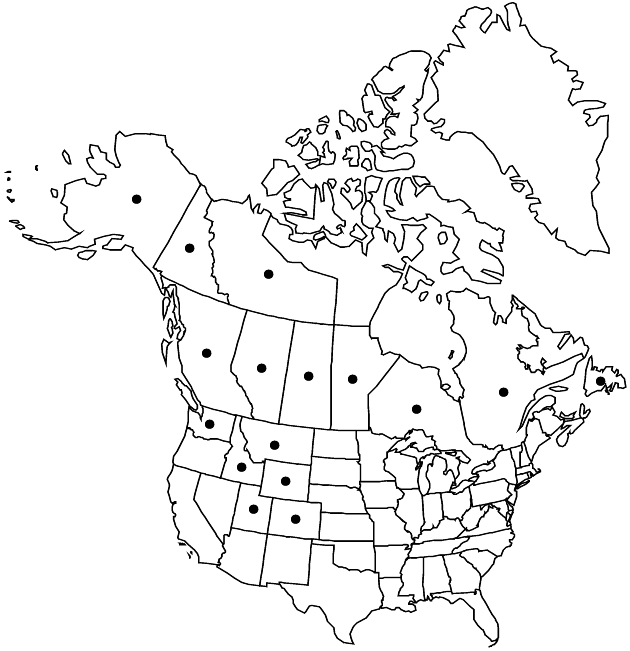Difference between revisions of "Antennaria pulcherrima"
Pittonia 3: 176. 1897.
FNA>Volume Importer |
FNA>Volume Importer |
||
| Line 15: | Line 15: | ||
|name=Antennaria pulcherrima var. angustisquama | |name=Antennaria pulcherrima var. angustisquama | ||
|authority=A. E. Porsild | |authority=A. E. Porsild | ||
| − | }}{{Treatment/ID/Synonym | + | }} {{Treatment/ID/Synonym |
|name=Antennaria pulcherrima var. sordida | |name=Antennaria pulcherrima var. sordida | ||
|authority=B. Boivin | |authority=B. Boivin | ||
| Line 31: | Line 31: | ||
|distribution=North America. | |distribution=North America. | ||
|discussion=<p>Subspecies 2 (2 in the flora).</p><!-- | |discussion=<p>Subspecies 2 (2 in the flora).</p><!-- | ||
| − | --><p>Antennaria pulcherrima is characterized by relatively large basal leaves, rhizomatous growth, and dark-colored phyllaries, each with a relatively large black spot at the base (R. J. Bayer and G. L. Stebbins 1987).</p> | + | --><p><i>Antennaria pulcherrima</i> is characterized by relatively large basal leaves, rhizomatous growth, and dark-colored phyllaries, each with a relatively large black spot at the base (R. J. Bayer and G. L. Stebbins 1987).</p> |
|tables= | |tables= | ||
|references= | |references= | ||
| Line 66: | Line 66: | ||
|publication year=1897 | |publication year=1897 | ||
|special status= | |special status= | ||
| − | |source xml=https://jpend@bitbucket.org/aafc-mbb/fna-data-curation.git/src/ | + | |source xml=https://jpend@bitbucket.org/aafc-mbb/fna-data-curation.git/src/8f726806613d60c220dc4493de13607dd3150896/coarse_grained_fna_xml/V19-20-21/V19_637.xml |
|tribe=Asteraceae tribe Gnaphalieae | |tribe=Asteraceae tribe Gnaphalieae | ||
|genus=Antennaria | |genus=Antennaria | ||
Revision as of 16:13, 18 September 2019
Dioecious. Plants (8–)30–65 cm (caudices branching or rhizomes stout). Stolons none. Basal leaves 3–5-nerved, spatulate to oblanceolate or lanceolate, 50–200 × 4–25 mm, tips acute, mucronate, faces gray-pubescent or silvery sericeous. Cauline leaves linear, 8–140 mm, distal flagged or not. Heads 3–30 in corymbiform to paniculiform arrays. Involucres: staminate 5–8 mm; pistillate 7–12 mm. Phyllaries distally black, dark brown, light brown, castaneous, or olivaceous. Corollas: staminate 3–5 mm; pistillate 3–6 mm. Cypselae 1–1.5 mm, glabrous; pappi: staminate 4–6 mm; pistillate (5–)8–10 mm. 2n = 28, 56.
Distribution

North America.
Discussion
Subspecies 2 (2 in the flora).
Antennaria pulcherrima is characterized by relatively large basal leaves, rhizomatous growth, and dark-colored phyllaries, each with a relatively large black spot at the base (R. J. Bayer and G. L. Stebbins 1987).
Selected References
None.
Key
| 1 | Cauline leaves: distal usually flagged; corollas: staminate 3.5–5 mm; pistillate 4–6 mm; wet sites, willow thickets, subalpine or subarctic, Colorado to Alaska, e to Ontario, w Quebec | Antennaria pulcherrima subsp. pulcherrima |
| 1 | Cauline leaves: mostly not flagged (sometimes flagged near heads); corollas: staminate 3–4 mm; pistillate 3–4.3 mm; limestone near sea level, w Newfoundland, Anticosti Island | Antennaria pulcherrima subsp. eucosma |